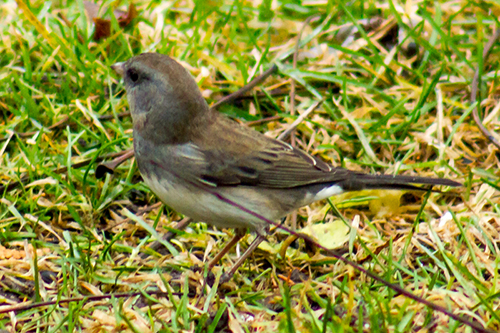Have you ever seen the Dark-eyed Junco before? You may have seen this bird if you live in Canada, Mexico, or any U.S. state. This is especially true if you have bird feeders in your yard.
However, it’s important to note that this bird can be seen in Florida but only in North Florida. In addition, these birds have some striking regional differences.
For example, there is the Oregon Junco, Slate-colored Junco, Pink-sided Junco, Red-backed Junco, Gray-headed Junco, and White-winged Junco. All of these are Dark-eyed Juncos in different regions!
These birds are widespread throughout most of the U.S. They can be found across the continent, from Alaska to Canada, California to New York, and Mexico.
Identification
The main differences between male and female Dark-eyed Juncos are their posture, behavior, and shape.
Both males and females are similar in size and color. It takes careful observation and some patience to distinguish between a male and a female. Female Dark-eyed Juncos have thinner necks because they lack the bulging neck feathers that males have.
They also have a more upright stance because they hold their head and body high. Male Dark-eyed Juncos have a more rounded head, while females have a tiny crest. Both males and females weigh around 0.67 ounces and have a body length of 4.9 to 6.5 inches.
Females are also lower on the pecking order. Males will chase females off, causing them to show fidgety movements and a higher activity level.
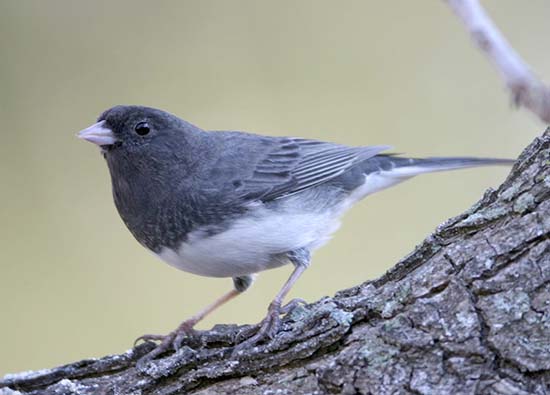
To learn about Dark-eyed Juncos’ coloration, check out the regional differences below.
Dark-eyed Juncos have a huge range of variations. There are 15 races, and 6 are easy to recognize. Fun fact, 5 of the 15 species used to be considered completely separate species until the 80s.
Because there are so many regional differences, we suggest using a field guide because that’s the best way to see complete illustrations. The “slate-colored” junco is smooth gray on top and white on the outer feathers and tail.
These juncos can be seen in most of Canada and the eastern United States. The “Oregon” junco has a light brown back, dark brown head, white belly, and buffy sides. These birds can be seen across the western U.S. More restricted regional differences include the “white-winged” and “pink-sided” juncos. These “white-winged” juncos are similar to the “slate-colored” junco and can be found in the Rockies.
The main difference between these two is the “white-winged” junco is a paler gray, dark face and white wing bars. The “pink-sided” junco is similar to the “Oregon” junco. It can be found in the western Great Plains and has pinkish-brown sides, a brown back, and a slate-gray head.
Food
Dark-eyed Juncos’ diet mainly consists of seeds, but they’re also known to eat insects.
Their year-round diet is 75% seeds like buckwheat, chickweed, sorrel, and lamb’s quarters. Dark-eyed Juncos can also be seen at bird feeders, where they prefer millet over all other seeds.
During breeding season, Dark-eyed Juncos will also eat insects like moths, beetles, butterflies, ants, caterpillars, flies, and wasps. Young Dark-eyed Juncos are strictly fed insects.
Nesting and Eggs
The female Dark-eyed Junco chooses the location for the nest. Nests are usually made in a depression or on sloping ground. For example, this could be in a fallen tree’s roots or a rock face. Dark-eyed Juncos have also been known to nest underneath or in buildings.
Rarely juncos nest on horizontal branches in hanging flower pots, light fixtures, and window ledges. They prefer to stay close to the ground, so nests are rarely placed in a location above 45 feet.
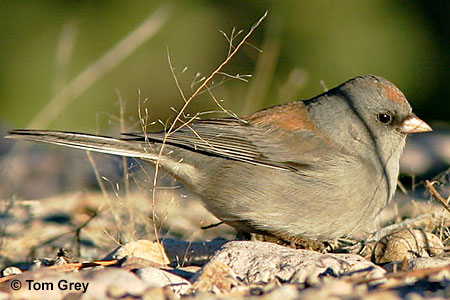
dark-eyed junco
Females will use their beaks to weave materials together when building a nest. She’ll also use her body to shape the nest.
Nests can vary significantly in terms of what they’re made with. Some nests, usually ones on the ground, are only lined with pine needles and grasses. On the other hand, nests that are built in taller items will be made with leaves, twigs, moss, ferns, grasses, hair, and rootlets.
Nest construction usually takes 3 to 7 days to build. When they’re finished, nests are around 3 to 5.5 inches across, have a depth of 1.6 to 2.8 inches, and have an inner diameter of 2.4 to 2.8 inches. It’s not common for Juncos to reuse a nest.
- Clutch size can range from 3 to 6 eggs.
- Egg length is usually 0.8 in (2.1 centimeters)
- Egg width is usually 0.6 in (1.6 centimeters)
- Eggs can vary in terms of color. They can be gray, pale bluish, pale greenish, or white. Sometimes they can be unmarked, but they usually have green, brown, or gray speckles.
Current Situation
Dark-eyed Juncos prefer to live in locations with maple, pine, spruce, fir, hickory, oak, cottonwood, and aspen trees.
They breed in the forests of North America and live in elevations that range from 11,000 feet to sea level. During migration and in the winter, they’re less picky regarding their habitats. They’ll live in fields, open woodlands, gardens, parks, and roadsides.
Dark-eyed Juncos have a large population, are widespread, and are commonly seen. It’s estimated that their population right now is 220 million. However, there was some decline in numbers between 1966 and 2019. At the moment, they are a species of low concern.
Facts
- The oldest bird of this species was at least eleven years and four months old. It was captured in West Virginia in 1991. It was recaptured and re-release in 2001, in the same state.
- Juncos winter in the southern states and into Mexico, they then retreat back north when spring hits. This makes them the “snowbirds” of the middle latitudes. Other juncos tend to be year-round residents of their range and they’ll usually retreat into woodlands during the breeding season.
- The Dark-eyed Junco can be found across North America, making it one of the most common birds on the continent. It can be seen in Canada, Alaska, California, New York, and Mexico.
Similar Species
The Dark-eyed Junco has features that are similar to other bird species. Here are some similar species:
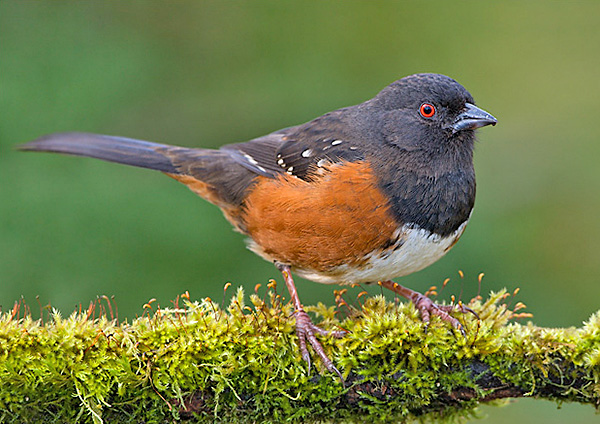
Spotted Towhee. Photograph © Glenn Bartley.
Spotted Towhee – Dark-eyed Juncos are much smaller in size than Spotted Towhees.
Also, Spotted Towhees are black on their backs, rather than brown or gray like Dark-eyed Juncos.
They have brighter reddish-orange color on their flanks than “Oregon” Juncos do.
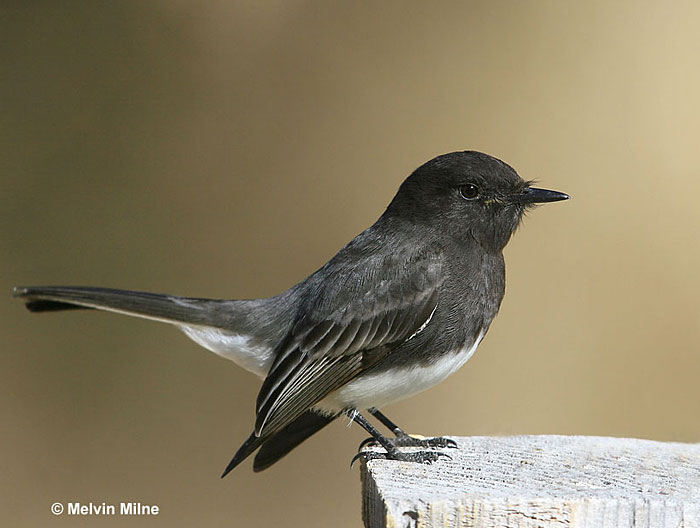
Black Phoebe
Black Phoebe – Black Phoebes have thin, straight bills and larger heads than Dark-eyed Juncos.
They also sit upright on perches that have no cover and catch flying insects instead of foraging on the ground.
Black Phoebes do have a magnificent dark plumage, that makes them stand out, but they do share some characteristics with Dark-eyed Juncos.
FAQ
How rare is a Dark-eyed Junco?
Dark-eyed Juncos are not very rare. In fact, they’re pretty common. They’ll even visit backyard bird feeders. They can be found throughout all of North America and will inhabit spaces that are close to humans.
Where are Dark-eyed Juncos found?
Dark-eyed Juncos are found in the forests of North America and in fields, open woodlands, gardens, parks, and roadsides of their wintering grounds. It can be seen in Canada, Alaska, California, New York, and Mexico.
Do Dark-eyed Juncos migrate?
Yes, Dark-eyed Juncos migrate. They migrate to the southern parts of the U.S. and Mexico.
What does a Dark-eyed Junco sound like?
Male birds sing a musical trill that stays pretty even throughout its duration. The trill lasts up to 2 seconds and can be 7 to 23 notes. Its song sounds similar to the Pine Warbler and the Chipping Sparrow. When flying or foraging, Juncos say a short but high chip note in rapid succession. The song is slower when foraging. When they’re feeling aggressive, they release a musical but sharp kew that encourages two birds to separate from each other.

